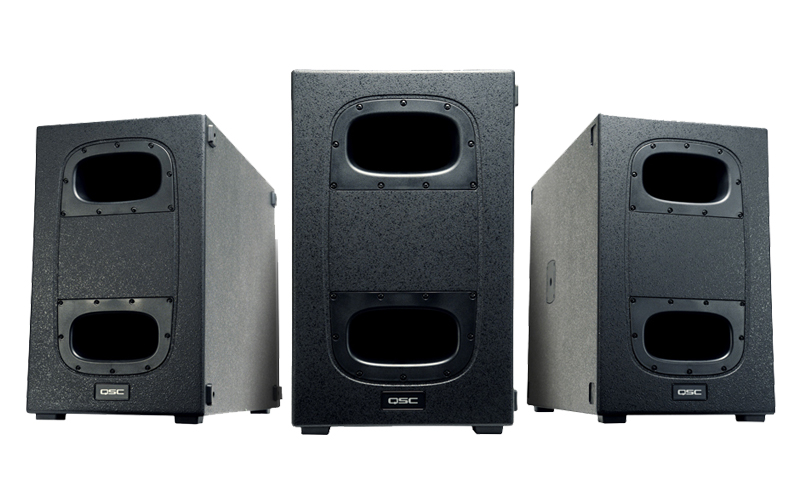07 Oktober 2018
QSC KS212C CARDIOID SUBWOOFER

Here's a familiar situation, whether you are a sound engineer, a musician or an audience member, at a bar, a wedding reception or a worship service. The mix is muddy and incoherent, thereís feedback and the level keeps creeping up as the band plays louder and louder. The Musicians can't hear themselves and the sound guy has lost control of the mix; pull the master faders down on the desk and the volume doesn't change.
It's easy to blame the drummer or the guitarist for playing too loud, but the underlying problem is often excessive low frequency energy from the P.A. Reduce the rear radiation from the subwoofers and the stage level drops. The musicians are no longer fighting to hear themselves, there's less leakage between microphones and now the sound engineer is back in control of the mix.
But aren't low frequencies omnidirectional? High-end concert sound providers have been creating subwoofer arrays to direct low frequency energy away from the stage for years, carefully positioning multiple boxes relative to each other, with some facing rearward, and applying complex DSP to manage the phase relationships between cabinets. Over the past couple of decades, various manufacturers have supplied complex cardioid subwoofer products to concert sound providers. But creating a cardioid, or heart-shaped, polar pattern with the energy radiating forward and a null to the rear typically requires lots of expensive equipment, physical space and technical expertise to make it work correctly. That puts it out of reach for people performing in smaller venues and with limited resources.
That's not to say that you can't create a cardioid pattern by adding a second or third subwoofer to your system. But there are so many parameters to consideróincluding the directivity, efficiency, frequency response and polar response for each transducer in the system that simply setting subs up at the correct distances, inverting the polarity of one of the boxes and adding a delay to align the phase will likely produce less than optimum results. It may even make things worse, boosting certain frequencies and generating a very uneven response.
QSC's new KS212C, the world's first-in-class single-box powered cardioid subwoofer, removes all the guesswork and hassle. Intended for portable entertainment and installation applications, it represents a breakthrough in innovation and design, uniquely providing all the benefits of a cardioid subwoofer array in a single, compact and highly portable enclosure. Most importantly, since one KS212C is all that's needed to achieve a cardioid effect, it requires no special or advanced audio skills to set it up or use it.
The KS212C is powered by a Dual 1800 W Class D amplifier, processed with QSCís latest DSP technology, and incorporates dual 12-inch long-excursion drivers that are each arranged in a sixth-order bandpass chamber. Through complex processing, these mirrored components interact at the rear of the enclosure to produce a desirable cancellation, while simultaneously interacting at the front of the enclosure to produce equally desirable summation. This results in a net 15 dB higher output at the front of the cabinet than at the rear.
The KS212C benefits from the R&D efforts that QSC has put into the K Series since launching the line in 2009. K Series was highly innovative at the time, creating a new category as the first active DSP product with a powerful Class D amplifier. Years later, our U.S. retailers report that the K12 remains their best-selling product across all categories, including instruments and amplification.
This new sub is really an extension to the K Series family of subwoofers. If you need a subwoofer that will fit in the back of your compact car, choose our KSUB. If you need additional low frequency extension for EDM, you may prefer our 18-inch KW181. For those situations where you need to ìkeep the bass in itsfers mobile entertainers, AV production professionals and modestly-sized performance venues an unparalleled ability to manage low frequencies on the stage, or anywhere that excessive noise behind the stage is undesirable.
As an example, one application for the KS212C might be a DJ working an outdoor wedding reception. A typical set-up could include a dancefloor in the middle of a large marquee or gazebo, with seating all around, including behind the speakers. You don't want all the low frequency going behind the dancefloor; you want some quiet zones within that area so that people can talk. In a similar application, such as an outdoor festival with multiple small stages, the cardioid polar pattern of the KS212C can be positioned such that low frequencies are directed away from nearby residences, reducing or eliminating the potential for complaints about the noise.
A couple of months ago, QSC announced K.2, our next-generation K Series, a redesign of the line from the ground up. Back in the late 1990s, high-end touring concert sound companies were using QSCís big PowerLight amplifiers. In the early 2000s, we redirected our engineering team to develop next-generation Class D technology for K Series and the PLD and CXD amplifier platforms. The new K.2 range and the KS212C represent an all-new fourth generation of QSC Class D amplification.
For our next Generation K.2 series and KS212C Cardioid Subwoofer, we also made a bold decision to utilize a much more powerful (and therefore more expensive) DSP than what is commonly found in this class of product. That decision is now paying off, ensuring that the KS212C when combined with the K.2 Series produces a very flat phase response through the crossover transition, and this in turn results in tighter and punchier bass.
Bass adds so much to live performance and dance music, but too much of a good thing in the wrong place can create a lot of problems. With the KS212C cardioid subwoofer, QSC offers the first practical and affordable solution to keep bass in its place.